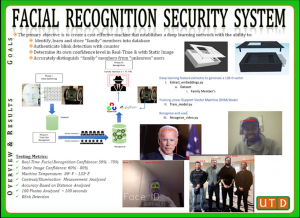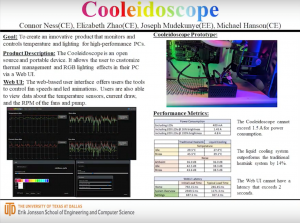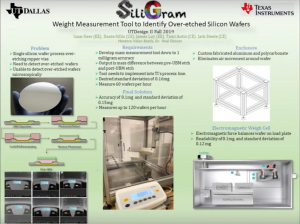Electrical and Computer Engineering UTDesign EXPO Winners – Fall 2019
First Place: Facial Recognition Security System

The first-place winners of the Electrical and Computer Engineering UTDesign EXPO developed a “Facial Recognition Security System,” sponsored by The University of Texas at Dallas. The team developed a cost-effective machine that established a deep learning network with the ability to identify, learn, and store “family” members into its database, authenticate blink detection with counter, determine its own confidence level in real-time and with static image, and accurately distinguish “family” members from “unknown” users. The machine is capable of analyzing 120 photos in about 30 – 40 seconds, with real-time facial recognition confidence measures between 50% – 70%, and static image confidence measures between 60% – 80%.
Second Place: Cooleidescope

The second-place winners of the Electrical and Computer Engineering UTDesign EXPO developed “Cooleidoscope: An Open Source Monitoring and Lighting Control System for PCs” as a product that monitors and controls temperature and lighting for high-performance PCs. The Cooleidoscope is an open source and portable device that utilizes a web-based user interface to allow the user to customize thermal management and RGB lighting effects in their PC. The Web UI offers tools to control fan speeds and LED animations, as well as metrics to view data about the temperature sensors, current draw, and the RPM of the fans and pumps. The Cooleidoscope power consumption cannot exceed 1.5 A, while the liquid cooling system outperforms the traditional heatsink system by 14%, and the Web UI latency cannot exceed 2 seconds.
Third Place: SiliGram

The third-place winners of the Electrical and Computer Engineering UTDesign EXPO developed “Siligram – Weight Measurement Solution for Over-Etched Wafers During Metal Plating,” sponsored by Texas Instruments. The team identified the problem within a single silicon wafer process over-etching copper vias, the need to detect over-etched wafers, but the inability to detect over-etched wafers microscopically. The enclosure included a custom fabricated aluminum and polycarbonate that eliminated air movement around the wafer. The electromagnetic weigh cell involved balancing the wafer on a load plate due to an electromagnetic force, establishing a readability of 0.1mg, and a standard deviation of 0.12mg. The project requirements sought to develop a mass measurement tool down to 1mg accuracy, and the ability to measure 60 wafers per hour. The Capstone team was able to develop a mass measurement tool with an accuracy of 0.1mg and standard deviation of 0.15mg with the capability to measure up to 120 wafers per hour.


